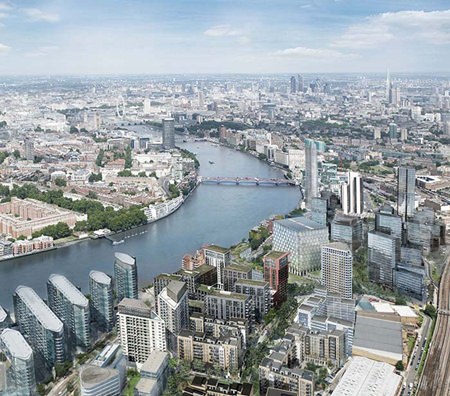Rising new technology industries and economic recovery are set to drive double digit rental growth in the fifteen leading global cities over the next five years, according to a new report released by property consultancy firm Knight Frank.
With rents at the start of a new cycle, a new wave of property development is expected to accommodate future economic growth. Building will be focused on new districts, like New York’s Brooklyn, and Nine Elms in London. Skyscrapers will be the preferred means of maximising sites to deliver large volumes of space.
 An artist’s graphic shows the Nine Elms development in London (bottom left).
An artist’s graphic shows the Nine Elms development in London (bottom left).
James Roberts, Head of Commercial Research at Knight Frank, said: “Premium pricing for real estate is found in those cities with the most high value knowledge workers, which consequently attract the world’s leading corporations. These are the ‘Global Cities’ and the they are set to experience double digit rental growth in their respective office markets due to substantial demand and restricted supply of new commercial stock.
“The race for knowledge workers and the attractiveness of firms operating in these sectors is borne out by our prediction for office rental growth, with San Francisco’s rents leading the way with an increase of 36.2 per cent by 2019, driven by the effect of Silicon Valley.”
The renaissance of demand for Madrid’s office market will see it achieve substantial growth and join Singapore as the biggest movers in the top ten list of office markets globally over the next five years.
“A new world of technology revolution with humans providing the creative impetus is generating a renaissance in the commercial property world,” added Roberts. “Firms today are scrambling to secure knowledge workers and the trend for a return to urban living has turned the global cities into talent magnets, and consequently multi-national corporations feel it is essential to locate within them.”
The report said restricted supply of new office stock in conjunction with this heightened demand for commercial space will see vacancy rates diminish in key cities by 2019 with the average vacancy rate dropping to just 6.3 per cent in the top 10 cities globally. Vacancy rates in Tokyo and London will drop to just 3.9 and 4.4 per cent respectively.
“Our data illustrates the opportunity for property investors and developers, who are in a position to exploit the growing trend for urban living across the globe,” explained Roberts. “There was $202bn of global commercial real estate investment in 2009 and we forecast this amount to increase to $606bn in 2015, as just a taste of market activity to come.”




